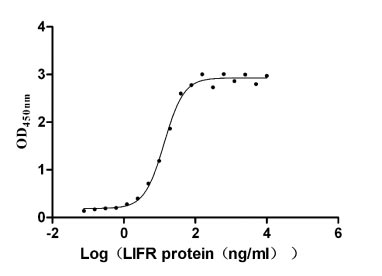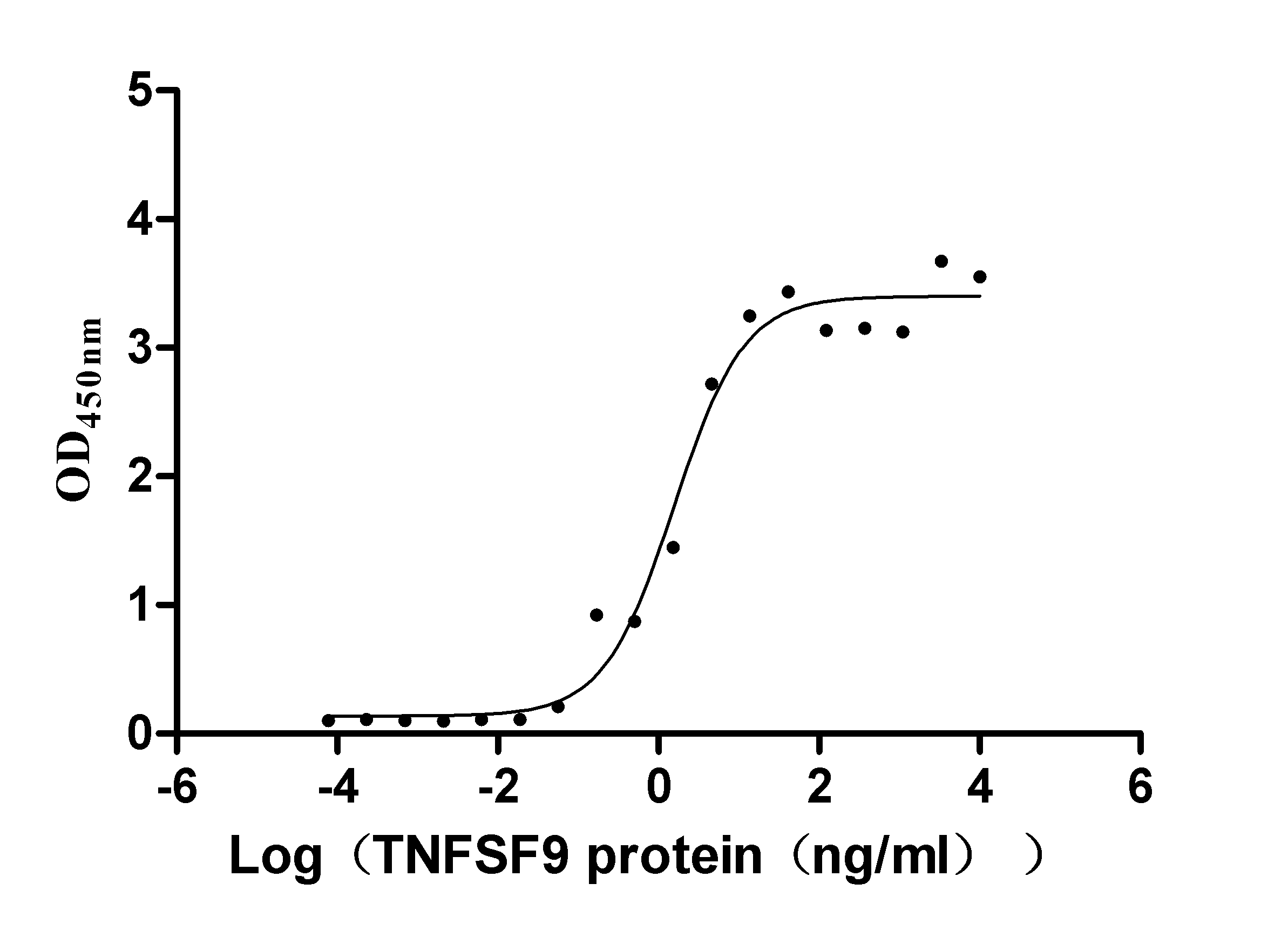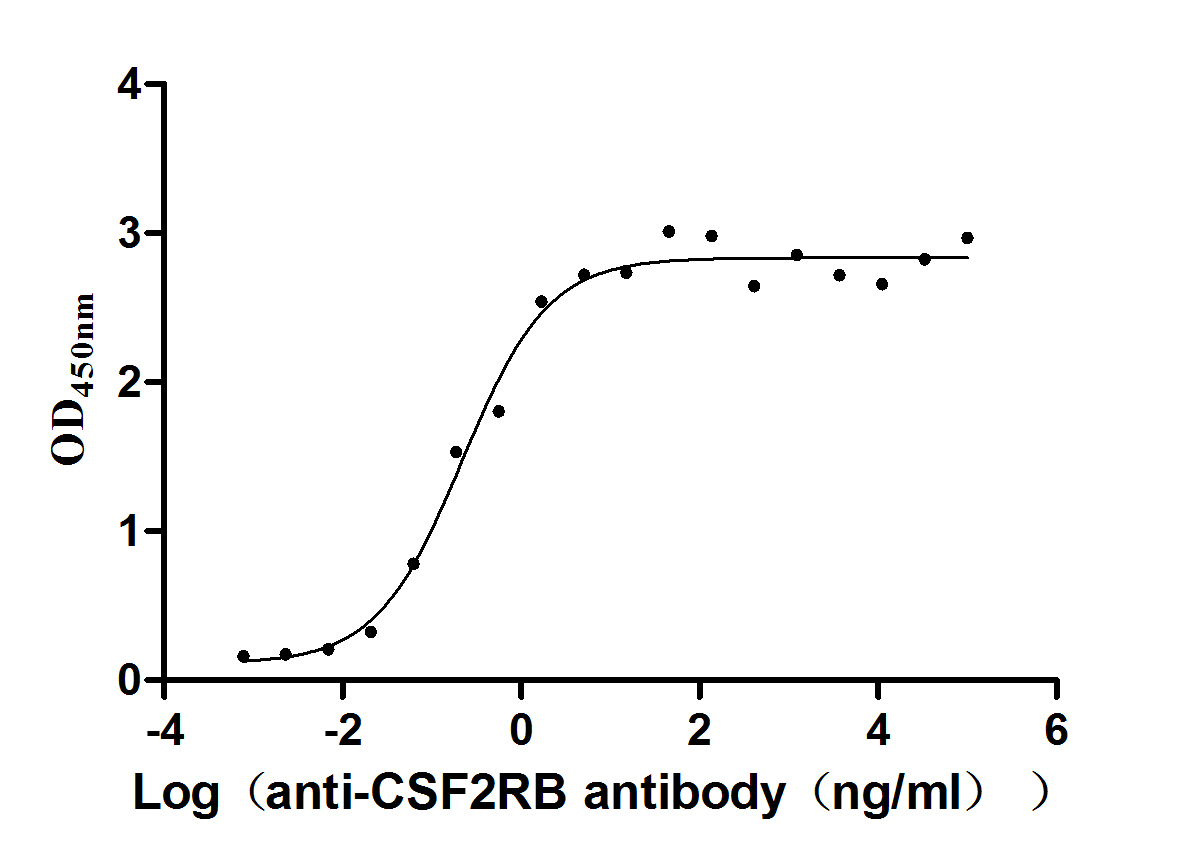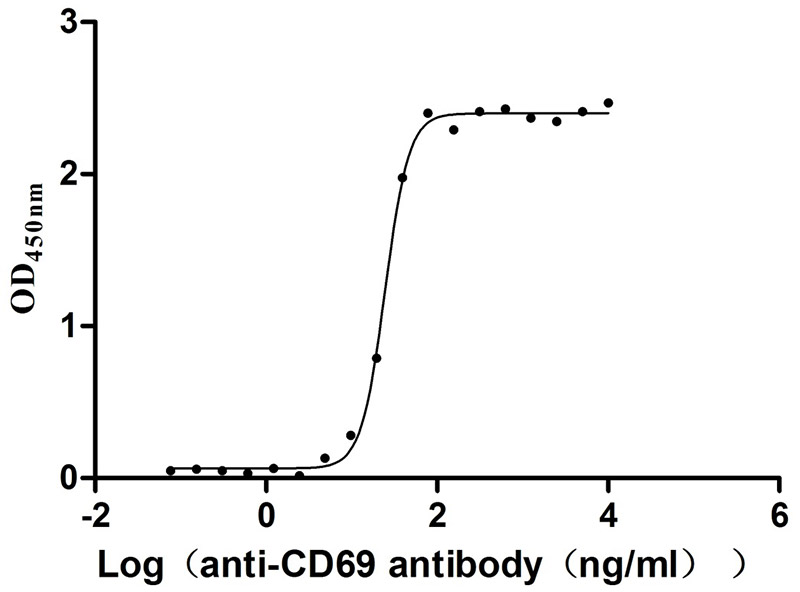Recombinant Mouse G-protein coupled bile acid receptor 1 (Gpbar1)
-
货号:CSB-CF773890MO
-
规格:
-
来源:in vitro E.coli expression system
-
其他:
产品详情
-
基因名:
-
Uniprot No.:
-
别名:Gpbar1; Tgr5; G-protein coupled bile acid receptor 1; Membrane-type receptor for bile acids; M-BAR
-
种属:Mus musculus (Mouse)
-
蛋白长度:full length protein
-
表达区域:1-329
-
氨基酸序列MMTPNSTELSAIPMGVLGLSLALASLIVIANLLLALGIALDRHLRSPPAGCFFLSLLLAG LLTGLALPMLPGLWSRNHQGYWSCLLLHLTPNFCFLSLLANLLLVHGERYMAVLQPLRPH GSVRLALFLTWVSSLFFASLPALGWNHWSPDANCSSQAVFPAPYLYLEVYGLLLPAVGAT ALLSVRVLATAHRQLCEIRRLERAVCRDVPSTLARALTWRQARAQAGATLLFLLCWGPYV ATLLLSVLAYERRPPLGPGTLLSLISLGSTSAAAVPVAMGLGDQRYTAPWRTAAQRCLRV LRGRAKRDNPGPSTAYHTSSQCSIDLDLN
Note: The complete sequence including tag sequence, target protein sequence and linker sequence could be provided upon request. -
蛋白标签:N-terminal 10xHis-tagged
-
产品提供形式:Liquid or Lyophilized powder
Note: We will preferentially ship the format that we have in stock, however, if you have any special requirement for the format, please remark your requirement when placing the order, we will prepare according to your demand. -
缓冲液:Lyophilized from Tris/PBS-based buffer, 6% Trehalose, pH 8.0
-
储存条件:Store at -20°C/-80°C upon receipt, aliquoting is necessary for mutiple use. Avoid repeated freeze-thaw cycles.
-
保质期:The shelf life is related to many factors, storage state, buffer ingredients, storage temperature and the stability of the protein itself.
Generally, the shelf life of liquid form is 6 months at -20°C/-80°C. The shelf life of lyophilized form is 12 months at -20°C/-80°C. -
货期:Basically, we can dispatch the products out in 1-3 working days after receiving your orders. Delivery time may differ from different purchasing way or location, please kindly consult your local distributors for specific delivery time.Note: All of our proteins are default shipped with normal blue ice packs, if you request to ship with dry ice, please communicate with us in advance and extra fees will be charged.
-
注意事项:Repeated freezing and thawing is not recommended. Store working aliquots at 4°C for up to one week.
-
Datasheet & COA:Please contact us to get it.
相关产品
靶点详情
-
功能:Receptor for bile acid. Bile acid-binding induces its internalization, activation of extracellular signal-regulated kinase and intracellular cAMP production. May be involved in the suppression of macrophage functions by bile acids. Involved in bile acid promoted GLP1R secretion.
-
基因功能参考文献:
- G-protein coupled bile acid receptor 1 (TGR5) is required for cold-induced beiging of subcutaneous white adipose tissue (scWAT). PMID: 29339725
- Work is the first to provide evidence for a TGR5-inhibited inflammatory response in ischemia/reperfusion injury through suppression of the TLR4-NF-kappaB pathway. PMID: 27597295
- contributes to hepatic cystogenesis by increasing cAMP and enhancing cholangiocyte proliferation PMID: 28543567
- findings show GPBAR1 is essential for maintaining intestinal immune homeostasis and that its activation in the setting of inflammation reverses the immune dysfunction that occurs in rodent models of colitis PMID: 28607110
- Data suggest that FXR and TGR5 expression is down-regulated in aging kidney; caloric restriction prevents these age-related changes. Additionally, in long-lived Ames dwarf mice, renal FXR and TGR5 expression is up-regulated. Treatment of aged mice with dual FXR/TGR5 agonist reverses age-related changes in kidney structure/function. (FXR = farnesoid X activated receptor; TGR5 = G protein-coupled bile acid receptor 1) PMID: 28596381
- GPBAR1/TGR5 receptor agonist, tauroursodeoxycholic acid, has anti-inflammatory effects in microglial cells. PMID: 27987324
- Vertical sleeve gastrectomy achieves its postoperative therapeutic effects through enhanced TGR5 signaling. PMID: 27312543
- These results suggest that TGR5 contributes to the glucoregulatory benefits of vertical sleeve gastrectomy surgery by promoting metabolically favourable shifts in the circulating bile acid pool. PMID: 26511794
- findings uncovered a novel mechanism in which INT-767 activation of FXR induces Tgr5 gene expression and increases Ca(2+) levels and cAMP activity to stimulate GLP-1 secretion and improve hepatic glucose and lipid metabolism in high-fat diet-induced obese mice. PMID: 28478385
- The results suggest that TGR5 activation mediates cross-talk between alpha- and beta-cells by switching from glucagon to GLP-1 to restore beta- cell mass and function under hyperglycemic conditions. PMID: 26757816
- TGR5 is an important mediator of bile acid-induced cholangiocyte proliferation in vivo and in vitro. Furthermore, TGR5 protects cholangiocytes from death receptor-mediated apoptosis. PMID: 26420419
- miR-26a is a target gene of bile acid receptor GPBAR-1/TGR5 PMID: 26107166
- Impaired Itching Perception in Murine Models of Cholestasis Is Supported by Dysregulation of GPBAR1 Signaling PMID: 26177448
- Data show that the action of bile acids on -like peptide-1 (GLP-1) secretion is predominantly mediated by G protein-coupled bile acid receptor GPBAR1 (TGR5) located on the basolateral L-cell membrane. PMID: 26280129
- TGR5 appears to be crucial for protecting the regenerating liver from bile acid overload. PMID: 26045264
- Activation of TGR5 alleviates neuroinflammation and improves outcome in hepatic encephalopathy. PMID: 26179031
- XGB increases BMR by TGR5-dependent mechanisms in mice PMID: 25738495
- these studies reveal a signaling pathway downstream of TGR5 that modulates chemokine expression in response to high-fat diet PMID: 25365223
- Bile acids induce pruritus in mice by co-activation of TGR5 and TRPA1. PMID: 25194674
- TGR5 mediates the bile acid-induced pro-inflammatory cytokine production in murine Kupffer cells. PMID: 24755711
- TGR5 is a critical element in testicular pathophysiology. PMID: 24798773
- GPBAR1 is essential to maintain gastric and intestinal mucosal integrity. GPBAR1 agonists protect against gastrointestinal injury caused by ASA and NSAIDs by a COX-independent mechanism. PMID: 22881598
- Stimulation of GPBAR1 enhances endothelial barrier function via activation of protein kinase A and Rac1. PMID: 24144793
- The receptor TGR5 protects the liver from bile acid overload during liver regeneration in mice. PMID: 23686672
- TGR5 agonism induces NO production via Akt activation and intracellular Ca(2+) increase in vascular endothelial cells, and this function inhibits monocyte adhesion in response to inflammatory stimuli. PMID: 23619297
- FXR/TGR5 activation coordinates the immune phenotype of monocytes and macrophages, both in vitro and in vivo, identifying potential targeting strategies for treatment of NAFLD. PMID: 23460643
- Bile acids activate TGR5 on sensory nerves, stimulating the release of neuropeptides in the spinal cord that transmit itch and analgesia. PMID: 23524965
- TGR5 receptor activation on smooth muscle reveals a novel mechanism for the regulation of gut motility by bile acids PMID: 23275618
- this study demonstrates that the TGR5 expressed in the pancreatic beta cells regulates insulin secretion and highlights the importance of ongoing therapeutic strategies targeting TGR5 in the control of glucose homeostasis. PMID: 23022524
- The receptor TGR5 mediates the effects of bile acids on colonic motility, and deficiency of TGR5 causes constipation in mice. PMID: 23041323
- Data suggest that TGR5 represents an essential component in the pathway mediating the enhanced GLP-1 release in response to anionic exchange resins. PMID: 22666533
- Bile acid binding resin and bile acid have similar effects on bile acid composition and thermogenesis, suggesting that they both are mediated via TGR5 activation PMID: 22952571
- TGR5 activation yields a significant immune modulating function in the prevention of atherosclerosis. PMID: 22152303
- GP-BAR1 regulates intestinal barrier structure. Its expression increases in rodent models of colitis and Crohn's disease. Ciprofloxacin is a GP-BAR1 ligand. PMID: 22046243
- These findings identify TGR5 as a negative mediator of inflammation that may serve as an attractive therapeutic tool for immune and inflammatory liver diseases. PMID: 21735468
- The G protein-coupled bile acid receptor, TGR5, stimulates gallbladder filling PMID: 21454404
- Activation of GPBAR1 receptors by hydrophobic bile salts leads to the opening of potassium K(ATP) channels. PMID: 20624794
- The TGR5 is localized in the primary cilium of mouse cholangiocytes and the receptor could play an important role in coupling biliary bile acid concentration and composition to ductular bile formation. PMID: 20623999
- Bile acids activate GpBAR1 on inhibitory motor neurons to release nitric oxide and suppress motility PMID: 20236244
- The discovery of the bile acid receptor, GpBAR1, represented a major step forward in our understanding of how cells can sense and respond to bile acids--{REVIEW} PMID: 20553563
- There is a gender-dependent regulation of Gpbar1 function in metabolic disease. PMID: 20354075
- Gpbar1 may play a critical role in the evolution of bile-acid-induced pancreatitis by coupling exposure to bile acids with generation of pathological intracellular calcium transients, intra-acinar cell zymogen activation, and acinar cell injury. PMID: 19900448
- TGR5 is implicated in the suppression of macrophage functions by bile acids PMID: 12524422
- bile acids induce GLP-1 secretion through TGR5 and intracellular cAMP production in STC-1 cells PMID: 15721318
- Gpbar1 plays a critical role in the formation of gallstones, possibly via a regulatory mechanism involving the cholesterol 7alpha-hydroxylase pathway. PMID: 16724960
- Our data suggest that both oleuropein and oleanolic acid are involved in the anti-diabetic effect of olive leaves and further emphasize the potential role of TGR5 agonists to improve metabolic disorders. PMID: 17825251
- TGR5 signaling induces intestinal glucagon-like peptide-1 release, leading to improved liver and pancreatic function and enhanced glucose tolerance in obese mice. PMID: 19723493
显示更多
收起更多
-
亚细胞定位:Cell membrane; Multi-pass membrane protein.
-
蛋白家族:G-protein coupled receptor 1 family
-
数据库链接:
KEGG: mmu:227289
STRING: 10090.ENSMUSP00000077135
UniGene: Mm.246587
Most popular with customers
-
Recombinant Human Leukemia inhibitory factor receptor (LIFR), partial (Active)
Express system: Mammalian cell
Species: Homo sapiens (Human)
-
Recombinant Human Tumor necrosis factor receptor superfamily member 9 (TNFRSF9), partial (Active)
Express system: Mammalian cell
Species: Homo sapiens (Human)
-
Recombinant Human Insulin growth factor-like family member 1 (IGFL1) (Active)
Express system: Mammalian cell
Species: Homo sapiens (Human)
-
Recombinant Human Cytokine receptor common subunit beta (CSF2RB), partial (Active)
Express system: Mammalian cell
Species: Homo sapiens (Human)
-
Recombinant Human Desmoglein-3 (DSG3), partial (Active)
Express system: Baculovirus
Species: Homo sapiens (Human)
-
Recombinant Human Early activation antigen CD69 (CD69), partial (Active)
Express system: Mammalian cell
Species: Homo sapiens (Human)
-
Recombinant Human Myosin regulatory light polypeptide 9 (MYL9) (Active)
Express system: Yeast
Species: Homo sapiens (Human)
-
Recombinant Macaca fascicularis Dipeptidase 3(DPEP3) (Active)
Express system: Mammalian cell
Species: Macaca fascicularis (Crab-eating macaque) (Cynomolgus monkey)




















